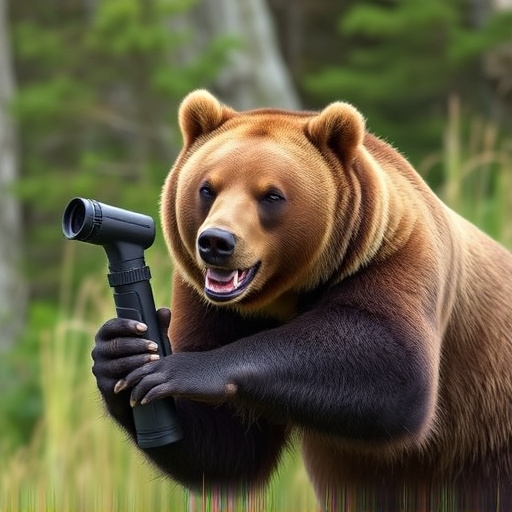Bear spray, a specialized pepper spray, offers non-lethal self-defense against aggressive bears up to a maximum distance coverage of 30 feet (10 meters). Effective range is influenced by wind direction, spray angle, nozzle design, and canister size. To maximize coverage, aim directly at the bear's face, eyes, and nose while sweeping from side to side, keeping a firm grip on the canister during deployment. Proper training, regular testing, and combining with noise makers enhance safety in bear-inhabited areas.
“Uncover the secrets behind bear spray’s impressive maximum distance coverage of thirty feet. This article delves into the science behind this powerful tool, designed to deter aggressive bears in emergency situations. We explore factors influencing its effective range and provide practical tips to ensure optimal usage. Learn how to maximize coverage, understand safety measures, and gain valuable insights for navigating encounters with these majestic creatures. Discover the best practices for making bear spray your reliable companion in remote outdoor spaces.”
- Understanding Bear Spray and Its Purpose
- Factors Affecting Effective Range
- How to Maximize Bear Spray Coverage Up to 30 Feet
- Safety Measures and Best Practices
Understanding Bear Spray and Its Purpose
Bear spray, also known as bear repellent, is a specialized pepper spray designed to deter and protect against aggressive bears. Its primary purpose is to provide individuals with a non-lethal means of self-defense while hiking, camping, or living in areas inhabited by bears. The spray creates an invisible barrier that irritates the bear’s eyes, nose, and respiratory system, causing it to retreat.
The effectiveness of bear spray lies in its maximum distance coverage, typically ranging up to thirty feet (10 meters). This range allows users to maintain a safe distance from potentially dangerous bears while enjoying outdoor activities. Understanding the bear spray maximum distance coverage is crucial for proper usage, ensuring individuals can effectively protect themselves without putting bears at risk through unnecessary exposure.
Factors Affecting Effective Range
The effective range of bear spray is typically quoted as thirty feet, but several factors can influence this distance. Wind direction and speed play a significant role; a tailwind can carry the spray further, while a headwind may reduce its maximum coverage. The angle at which the spray is directed also matters; spraying directly at the bear might result in better penetration than a more lateral approach.
The type of bear spray, nozzle design, and canister size are other critical variables. Different sprays have varying concentrations of capsaicin, the active ingredient causing irritation to bears. Larger canisters offer longer range but may have lower concentration levels. Nozzle designs impact spray pattern and dispersion, affecting how far and evenly the solution reaches.
How to Maximize Bear Spray Coverage Up to 30 Feet
To maximize bear spray coverage up to 30 feet, it’s crucial to understand how and when to deploy it effectively. First, ensure you’re within the recommended range; at 30 feet, direct spray should cover your entire body. Aim for the face, eyes, and nose of the bear, as these areas are sensitive and can deter an attack. Spraying in a sweeping motion from side to side can help achieve maximum coverage while minimizing wastage.
Additionally, maintain a firm grip on the canister during deployment; this prevents it from slipping or rolling away. In case of unexpected encounters, practice regularly so you’re comfortable with the spray’s range and patterns. Bear spray is most effective when used correctly, offering valuable time to escape or re-evaluate your position.
Safety Measures and Best Practices
When carrying bear spray, understanding its effective range is crucial for your safety in potential encounters. The maximum distance coverage typically ranges from 30 to 40 feet (9 to 12 meters), making it a valuable tool for deterring bears when camping or hiking in bear country. However, this range is not invariable; factors like wind conditions, spray technique, and the type of bear can influence its effectiveness.
To maximize the safety measures, always follow best practices: ensure proper training on how to use bear spray effectively, carry it in an easily accessible location, and familiarize yourself with local guidelines for its usage. Regularly test the spray’s functionality before embarking on outdoor adventures to guarantee its reliability when needed most. Additionally, combining bear spray with other deterrents like noise makers can further reduce potential risks during encounters with these majestic yet potentially dangerous animals.
Bear spray is an essential tool for navigating wild environments, offering a safe and effective way to deter aggressive bears up to 30 feet away. By understanding the factors influencing its range and implementing best practices for application, individuals can maximize protection during outdoor activities. Remember that proper usage and safety measures are crucial to ensuring bear spray remains a reliable game-changer in preventing unwanted encounters with these majestic creatures.
